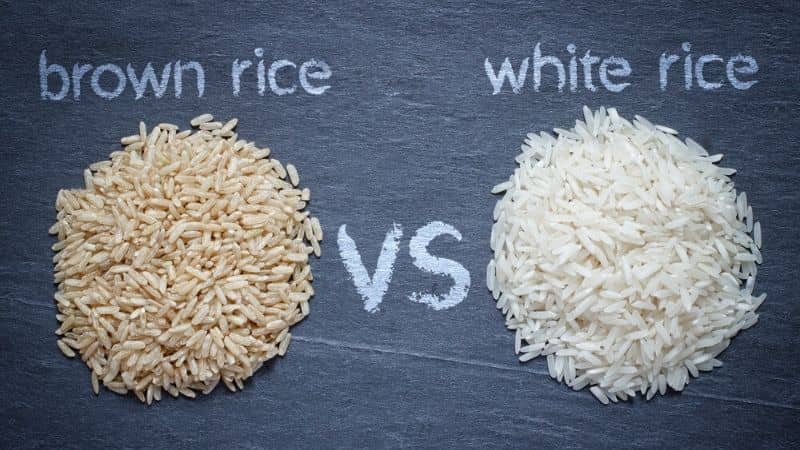Rice is one of the favorite foods of people all over the world and especially people of India enjoy eating rice more commonly. As rice provides you a significant amount of carbs, proteins, vitamins, and minerals, the rice nutrition facts are the main reason why people consume them so much.
There are different kinds of rice available in India – brown rice and white rice are the most common ones between all types. We, at Lifestyle Titbits, will compare brown and white rice on a nutrition basis to help you understand the nutrient's value and benefits of both of them.
Brown rice is the base of all white rice. The husk, bran, and germ of the rice are eliminated during milling. This method improves the life span of white rice while also extracting much of its nutrients, such as fibers, vitamins, and minerals.
White rice processing gets you less nutrients and does get better taste but prevents you the best due to artificial means. The processed grain is cleaned to make it look more appealing. Carbohydrate content is significant in both brown and white rice. Keep following Lifestyle Titbits to know more details on this and other effective titbits that will enable you to live the healthy, pleasing, and active life you deserve.
Brown rice is recognized as a whole grain. It has a greater nutritional content than its paler equivalent. Whole-grain diets have been found to reduce cholesterol levels and the likelihood of stroke, cardiovascular disease, and type 2 diabetes. You may also like to know the best brown rice brands in India to get the most efficient product to fulfill your needs.
Nutritional Differences Between Brown and White Rice
Brown rice may appear to be the better item because it comprises the nutrient-rich bran and germ but it's not that easy. In reality, both types of rice have nutritional advantages. Complete details about both brown rice nutrition and white rice nutrition will enable you to understand their differences clearly. So let's compare brown rice vs white rice.
1. Nutrients
Brown rice has more essential nutrients than white rice because it comprises the nutrient-rich bran and germ. Brown rice has a higher content of thiamine, niacin, and magnesium than white rice and it also has increased levels of zinc, folate, iron, riboflavin, and manganese than white rice. While white rice contains vital nutrients, the total amount is reduced due to the absence of bran and germ.
2. Anti-nutrients
Though brown rice has more essential nutrients than white rice, the existence of the bran and germ on the whole grain can cause some problems. Brown rice includes plant components called phytates, also classified as anti-nutrients, which are available to assist secure the grain before it is time to ripen because the bran is a defensive coating for the grain.
Sadly, anti-nutrients like phytic acid make it impossible for our bodies to digest and consume many of the nutrients found in brown rice. Phytates can stick to minerals like zinc, magnesium, and calcium, stopping them from being digested by the body.
3. Protein
While the amount of protein in brown rice is not much significant, brown rice has a marginally greater protein content than white rice. A cup of brown rice will give you 5.5 grams of protein while the same amount of white rice will supply 4.3 grams of protein.
4. Carbohydrates
Carbs in brown rice and white rice are found in high amounts. Due to the presence of bran and germ in brown rice, brown rice carbs are slightly higher than white rice. The higher content of carbohydrates in brown rice provides you various health benefits.
You will receive 52 grams of carbs from a one-cup serving of brown rice and 45 grams of carbs from the same amount of white rice.
5. Fat
Availability of bran in the whole gran increases the number of fats in it. While bran-less white rice contains a negligible amount of white rice. One cup of brown rice provides you 2 grams of fat as compared to 0.4 grams received from the same amount of white rice.
6. Calories
As the whole grain (brown rice) contains bran which is a good source of fats and proteins, you will receive 248 calories from a one-cup serving of brown rice. The same amount of white rice will provide you 204 calories.
7. Fiber
Brown rice is enriched with fiber due to the presence of bran in it, so it contains slightly higher amounts of fiber as compared to white rice.
8. Glycemic Index
Ultimately, since brown rice contains more fiber and protein than white rice, it is often promoted as the healthier option due to its lower glycemic index (GI) score; however, research shows that this is not always the case. A food's GI score is a measure of how much of an influence it has on blood sugar levels; the higher the number, the bigger the effect.
If you talk about the GI score of both brown and white rice, white rice has a greater GI score of 72 as compared to brown rice’s 50. Some studies have found that the gap is small and that grain products (white rice) have a greater effect on blood sugar.
While brown rice comprises marginally more nutrients and fiber than white rice, the variation between the two is minor. Brown rice and white rice are both nutritious and can be eaten in moderation.
White rice, in reality, is easier to absorb for many people because it lacks the bran, germ, and anti-nutrients found in brown rice. Furthermore, since the calories gap between the two is so slight, comparing brown rice vs white rice isn't worth the effort; instead, simply select which form you prefer.
We hope all this information would have helped you to understand the nutrition value and advantages of both brown and white rice. The essential nutrients in both rice are almost equal and the gap is small, so you can use either of them as per your desires.

